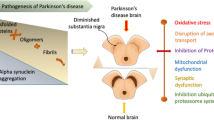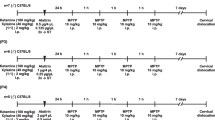Abstract
To investigate the effects of Lycium barbarum polysaccharide (LBP) on pathological symptoms and behavioral deficits in a Methyl-4-phenyl-1,2,3,6-tetrahydropyridine (MPTP)-induced Parkinson’s disease (PD) mouse model. The therapeutic effects of LBP were monitored with an Open field test, a Rotarod test and a Morris water maze test. We also investigated the mechanisms with qRT-PCR and Western blotting analyses. After a relatively short-term LBP treatment, the total distance and walking time of PD mice significantly increased. The staying duration on the rod of PD mice increased in the Rotarod test. LBP can up-regulate levels of SOD2, CAT and GPX1 and inhibit the abnormal aggregation of α-synuclein induced by MPTP. LBP treatment can also up-regulate the phosphorylation of AKT and mTOR, and may play its protective role by activating the PTEN/AKT/mTOR signaling axis. These results suggest that LBP can effectively alleviate the degeneration in the nigrostriatal system induced by MPTP treatment. It may be a potential candidate for the treatment of Parkinson’s disease.









Similar content being viewed by others
References
Esposito E, Rotilio D, Di Matteo V, Di Giulio C, Cacchio M, Algeri S (2002) A review of specific dietary antioxidants and the effects on biochemical mechanisms related to neurodegenerative processes. Neurobiol Aging 23:719–735
Bi W, Zhang G, Sun Y, Zhu L, Wang C, Liang Y, Shi Q, Tao E (2011) Serine 129 phosphorylation of alpha-synuclein cross-links with tissue transglutaminase to form Lewy body-like inclusion bodies. ISRN Neurol 2011:732879. https://doi.org/10.5402/2011/732879
Quinn JG, Coulson DT, Brockbank S, Beyer N, Ravid R, Hellemans J, Irvine GB, Johnston JA (2012) Alpha-Synuclein mRNA and soluble alpha-synuclein protein levels in post-mortem brain from patients with Parkinson’s disease, dementia with Lewy bodies, and Alzheimer’s disease. Brain Res 1459:71–80
Bosco DA, Fowler DM, Zhang Q, Nieva J, Powers ET, Wentworth P Jr, Lerner RA, Kelly JW (2006) Elevated levels of oxidized cholesterol metabolites in Lewy body disease brains accelerate alpha-synuclein fibrilization. Nat Chem Biol 2:249–253
Asanuma MI, Miyazaki, Ogawa N (2003) Dopamine- or L-DOPA-induced neurotoxicity: the role of dopamine quinone formation and tyrosinase in a model of Parkinson’s disease. Neurotox Res 5:165–176
Graham DG, Tiffany SM, Bell WR Jr, Gutknecht WF (1978) Autoxidation versus covalent binding of quinones as the mechanism of toxicity of dopamine, 6-hydroxydopamine, and related compounds toward C1300 neuroblastoma cells in vitro. Mol Pharmacol 14:644–653
Pukaß K, Goldbaum O, Richter-Landsberg C (2015) Mitochondrial impairment and oxidative stress compromise autophagosomal degradation of α-synuclein in oligodendroglial cells. J Neurochem 135:194–205
Chan T, Chow AM, Cheng XR, Tang DW, Brown IR, Kerman K (2012) Oxidative stress effect of dopamine on α-synuclein: electroanalysis of solvent interactions. ACS Chem Neurosci 3:569–574
Suresh SN, Chavalmane AK, Dj V, Yarreiphang H, Rai S, Paul A, Clement JP, Alladi PA, Manjithaya R (2017) A novel autophagy modulator 6-Bio ameliorates SNCA/α-synuclein toxicity. Autophagy 13:1221–1234
Xilouri M, Brekk OR, Polissidis A, Chrysanthou-Piterou M, Kloukina I, Stefanis L (2016) Impairment of chaperone-mediated autophagy induces dopaminergic neurodegeneration in rats. Autophagy 11:2230–2247
Hopkins BD, Hodakoski C, Barrows D, Mense SM, Parsons RE (2014) PTEN function: the long and the short of it. Trends Biochem Sci 39:183–190
Vivanco I, Sawyers CL (2002) The phosphatidylinositol 3-kinase AKT pathway in human cancer. Nat Rev Cancer 2:489–501
Shi Y, Wang J, Chandarlapaty S, Cross J, Thompson C, Rosen N, Jiang X (2014) PTEN is a protein tyrosine phosphatase for IRS1. Nat Struct Mol Biol 21:522–527
Jiang BH, Liu LZ (2009) PI3K/PTEN signaling in angiogenesis and tumorigenesis. Adv Cancer Res 102:19–65
Bueno MJ, Perez de CI, Malumbres M (2008) Control of cell proliferation pathways by microRNAs. Cell Cycle 7:3143–3148
Switon K, Kotulska K, Janusz-Kaminska A, Zmorzynska J, Jaworski J (2017) Molecular neurobiology of mTOR. Neuroscience 341:112–153
Christie KJ, Webber CA, Martinez JA, Singh B, Zochodne DW (2010) PTEN inhibition to facilitate intrinsic regenerative outgrowth of adult peripheral axons. J Neurosci 30:9306–9315
Huang Z, Hu Z, Xie P, Liu Q (2017) Tyrosine-mutated AAV2-mediated shRNA silencing of PTEN promotes axon regeneration of adult optic nerve. PLoS ONE 12:e0174096
Chen Z, Kwong Huat Tan B, Chan SH (2008) Activation of T lymphocytes bypolysaccharide-protein complex from Lycium barbarum L. Int Immuno Pharmacol 8:1663–1671
Gan L, Zhang SH, Liu Q, Xu HB (2003) A polysaccharide-protein complex from Lycium barbarum upregulates cytokine expression in human peripheral bloodmononuclear cells. Eur J Pharmacol 471:217–222
He MH, Pan H, Chang RCC, So KF, Brecha NC, Pu ML (2014) Activation ofthe nrf2/HO-1 antioxidant pathway contributes to the protective effects of Lycium barbarum polysaccharides in the rodent retina after ischemia-reperfusion-induced damage. PLoS ONE 9:e84800
Ho YS, Yu MS, Lai CS, So KF, Yuen WH, Chang RC (2007) Characterizing theneuroprotective effects of alkaline extract of Lycium barbarum on beta-amyloidpeptide neurotoxicity. Brain Res 1158:123–134
Luo Q, Cai Y, Yan J, Sun M, Corke H (2004) Hypoglycemic and hypolipidemiceffects and antioxidant activity of fruit extracts from Lycium barbarum. Life Sci 76:137–149
Wang TF, Li YX, Wang YS, Zhou R, Ma L, Hao YJ, Jin SJ, Du J, Zhao CJ, Sun T, Yu JQ (2014) Lycium barbarum polysaccharide prevents focal cerebralischemic injury by inhibiting neuronal apoptosis in mice. PLoS ONE 9:e90780
Wang HB, Li YX, Hao YJ, Wang TF, Lei Z, Wu Y, Zhao QP, Ang H, Ma L, Liu J, Zhao CJ, Jiang YX, Wang YR, Dai XY, Zhang WN, Sun T, Yu JQ (2013) Neuroprotective effects of LBP on brain ischemic reperfusion neurodegeneration. Eur Rev Med Pharmacol Sci 20:2760–2765
Gao K, Liu MY, Cao JY, Yao MN, Lu YY, Li JK, Zhu XH, Yang ZF, Wen AD (2014) Protective effects of Lycium barbarum polysaccharide on 6-OHDA-induced apoptosis in PC12 cells through the ROS-NO pathway. Molecules 20:293–308
Amagase H, Sun B, Borek C (2009) Lycium barbarum (goji) juice improves in vivo antioxidant biomarkers in serum of healthy adults. Nutr Res 29:19–25
Li XM (2007) Protective effect of Lycium barbarum polysaccharides on streptozotocin-induced oxidative stress in rats. Int J Biol Macromol 40:461–465
Mi XS, Chiu K, Van G, Leung JW, Lo AC, Chung SK, Chang RC, So KF (2012) Effect of Lycium barbarum Polysaccharides on the expression of endothelin-1 and its receptors in an ocular hypertension model of rat glaucoma. Neural Regen Res 7:645–651
Naduthota RM, Bharath RD, Jhunjhunwala K, Yadav R, Saini J, Christopher R, Pal PK (2017) Imaging biomarker correlates with oxidative stress in Parkinson’s disease. Neurol India 65:263–268
Yamato M, Kudo W, Shiba T, Yamada KI, Watanabe T, Utsumi H (2010) Determination of reactive oxygen species associated with the degeneration of dopaminergic neurons during dopamine metabolism. Free Radic Res 44:249–257
Haavik J, Toska K (1998) Tyrosine hydroxylase and Parkinson’s disease. Mol Neurobiol 16:285–309
Weinreb O, Mandel S, Youdim MB, Amit T (2013) Targeting dysregulation of brain iron homeostasis in Parkinson’s disease by iron chelators. Free Radic Biol Med 62:52–64
Jomova K, Vondrakova D, Lawson M, Valko M (2010) Metals, oxidative stress and neurodegenerative disorders. Mol Cell Biochem 345:91–104
Kim M, Ho A, Lee JH (2017) Autophagy and human neurodegenerative diseases-a fly’s perspective. Int J Mol Sci 18:E1596
Ross CA, Poirier MA (2004) Protein aggregation and neurodegenerative disease. Nat Med 10:S10–S17
Swaminathan G, Zhu W, Plowey ED (2016) BECN1/Beclin 1 sorts cell-surface APP/amyloid β precursor protein for lysosomal degradation. Autophagy 12:2404–2419
Wang ZY, Zhou LQ, Zheng XT, Chen G, Pan RF, Li JH, Liu WG (2017) Autophagy protects against PI3K/Akt/mTOR-mediated apoptosis of spinal cord neurons after mechanical injury. Neurosci Lett 656:158–164
Kim SH, Son KM, Kim KY, Yu SN, Park SG, Kim YW, Nam HW, Suh JT, Ji JH, Ahn SC (2017) Deoxypodophyllotoxin induces cytoprotective autophagy against apoptosis via inhibition ofPI3K/AKT/mTOR pathway in osteosarcoma U2OS cells. Pharmacol Rep 69:878–884
Funding
This study was supported by the National Natural Science Foundation of China [No. 81501135], the Natural science fund for colleges and universities in Jiangsu Province [No. 15KJB310026], the The science and technology projects fund of Yangzhou City [No. YZ2015112]
Author information
Authors and Affiliations
Corresponding authors
Rights and permissions
About this article
Cite this article
Wang, X., Pang, L., Zhang, Y. et al. Lycium barbarum Polysaccharide Promotes Nigrostriatal Dopamine Function by Modulating PTEN/AKT/mTOR Pathway in a Methyl-4-phenyl-1,2,3,6-tetrahydropyridine (MPTP) Murine Model of Parkinson’s Disease. Neurochem Res 43, 938–947 (2018). https://doi.org/10.1007/s11064-018-2499-6
Received:
Revised:
Accepted:
Published:
Issue Date:
DOI: https://doi.org/10.1007/s11064-018-2499-6




